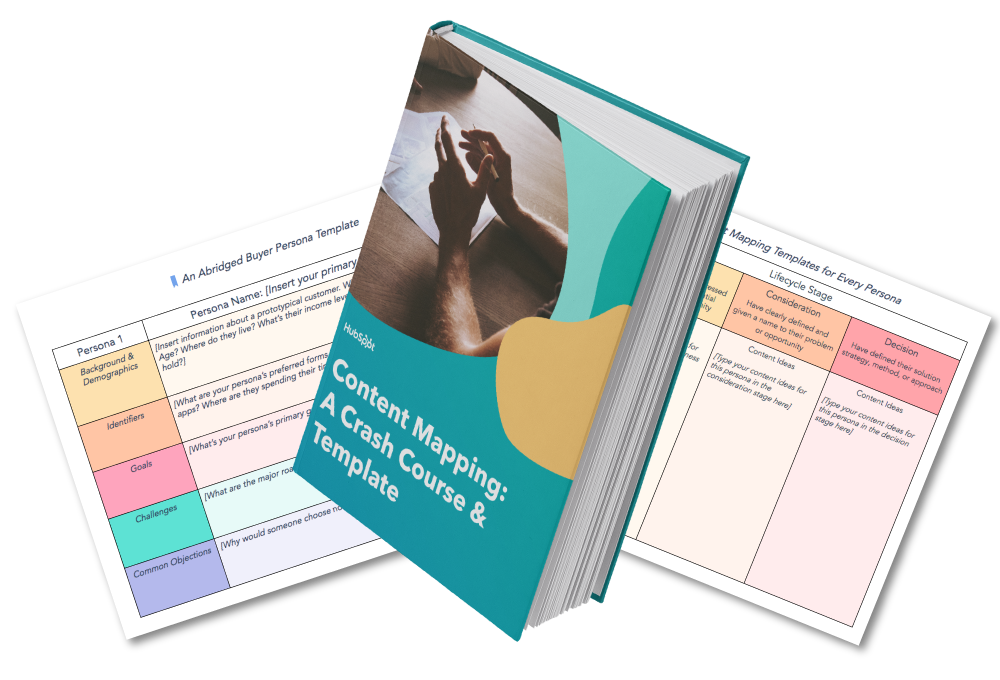What is a Content Map?
A content map is a plan to deliver the right content, to the right people, at the right time. Content mapping takes into account the characteristics of the person who will be consuming the content and their lifecycle stage.
Marketers hear it all the time: The content you create needs to be personalized. It needs to be aligned with the wants and needs of your customers (and prospective customers). It needs to resonate with them. It needs to feel like it was created just for them.
On its surface, this sounds like great advice. Personalization, giving people content that they're actually interested in ... it makes perfect sense. But coming up with the actual topics that make for a highly targeted content strategy isn't that easy.
To help you brainstorm and map out content ideas for targeting specific segments of your audience, we've created a new free template resource: Content Mapping Template: Using Buyer Personas & Lifecycle Stages to Create Targeted Content.
I'll talk more about how you can use this template in a bit. But first, let’s take a look at how this whole "content mapping" business works.
And when think you've got this concept down, you'll want to check out HubSpot Academy's free content marketing training resource page to learn how to map a content strategy for your business.
What Is Content Mapping?
When it comes to content, one size rarely fits all. To ensure that your company's content is effective at generating and nurturing leads, you need to deliver the right content, to the right people, at the right time. Content mapping is the process of doing just that.
With content mapping, the goal is to target content according to:
- The characteristics of the person who will be consuming it (that’s where buyer personas come in).
- How close that person is to making a purchase (i.e. their lifecycle stage).
Buyer Personas
Buyer personas are fictional, generalized representations of your ideal customers. They help you understand your customers (and prospective customers) better, and make it easier for you to tailor content to the specific needs, behaviors, and concerns of different groups.
The strongest buyer personas are based on market research as well as on insights you gather from your actual customer base (through surveys, interviews, etc.). Depending on your business, you could have as few as one or two personas, or dozens. If you’re just getting started with personas, don’t go crazy! You can always develop more personas later if needed.
Lifecycle Stages
The buyer persona you target with your content i s just one half of the content mapping equation. In addition to knowing who someone is, you need to know where they are in the buying cycle (i.e. how close they are to making a purchase). This location in the buying cycle is known as a lifecycle stage.
For the purposes of our Content Mapping Template, we’re divvying up the buying cycle into three lifecycle stages: Awareness, Consideration, & Decision.
- Awareness: In the awareness stage, a person has realized and expressed symptoms of a potential problem or opportunity.
- Consideration: In the consideration stage, a person has clearly defined and given a name to their problem or opportunity.
- Decision: In the decision stage, a person has defined their solution strategy, method, or approach.
By combining buyer personas with lifecycle stages, you can really hone in on specific segments of your audience and tailor content to resonate with each of those segments.
How to Use a Content Mapping Template
To help you create a content map for your own team, we've created a downloadable content mapping template. The template includes an introduction to content mapping, a crash course on buyer personas and lifecycle stages, a content mapping template (plus examples), and bonus buyer persona templates.
With the template, you'll learn how to understand buyer personas and lifecycle stages, identify problems and opportunities that your audience needs help with, and brainstorm highly targeted content ideas that incorporate personas and lifecycle stages.
This template is available in both Google Docs and Microsoft Word.
Whether you want to download our content mapping template or create your own, let's dive into the structure of a content mapping template.
In our Content Mapping Template, we created a simple grid system, putting buyer persona (and a key problem or opportunity that persona is struggling with) along the y-axis and lifecycle stage along the x-axis. As you move from left to right, you're effectively moving down the funnel.
Your awareness stage content should target the top of the funnel (TOFU). People in this segment are just becoming aware that they have a problem. At this stage, don't try to beat them over the head with product-focused content. Instead, think of how your content can help people become more informed about the problem in general, and you'll (hopefully) find that they continue moving down your funnel as they search for solutions.
Your consideration stage content, in comparison, can more explicitly mention how your product or service could potentially solve a problem. Keep in mind, however, that at this point in the buying cycle, people are still evaluating their options. So while case studies and demo videos are fine, save your more sales-focused content (estimates, free trials, etc.) for the next stage.
At the decision stage of the game, you can really lean into marketing your products or services. If someone has reached this stage, they've already identified a problem and a solution, and are now getting ready to pull the proverbial trigger.
Not quite convinced that content mapping is worth it? Let's hear from some marketers who are actually doing this stuff ...
Content Mapping Tips From the Pros

"The best part about inbound is that you can give your prospects the information they are asking for before they even ask for it. Buyer personas and lifecycle stages allow you to be one step ahead of the game by mapping out what your prospect's next steps are and delivering them the content from numerous different avenues.
We create buyer personas as part of our onboarding process and everything we do from content offer to daily tweets is centered around that document. We also always ask ourselves, 'Would business owner Bob open this email, click this tweet, download this offer, etc.?'"
- Laura Hogan ( Marketing Manager, OverGo Studio)

"When mapping out content for your site's visitors, it's important to remember that when it comes to purchasing decisions (BOFU conversions, especially for B2B and high-priced items), there are some personas out there who would rather speak to someone on their terms rather than fill out a form for a consultation. Understanding how they are most comfortable when it comes to making decisions can help you understand what points of conversion will be the most relevant and successful for that persona.
Optimizing your site pages (landing and thank you pages, as well), TOFU & MOFU offers, and workflows with direct contact information (phone #, email, etc.) is a great way to ensure that visitors, prospects and leads who may shy away from form submissions still have readily available, alternate means of converting."
- Marc Herschberger ( Inbound Coordinator, Revenue River Marketing)

"Mapping out buyer personas and lifecycle stages is extremely important when creating content. In terms of buyer personas, it's easy to see that a Marketing Director will have different questions, information needs, and interests compared to a CEO. Both of these personas may be searching for your product or service, but they'll be looking for different topics. By creating content that appeals to each audience, you can be more effective in attracting that specific audience.
By the same token, each persona of yours may be in a different stage of the buying process, so it's important to think through and create content that appeals to someone looking for basic, high-level information such as an ebook, as well as specific information like a pricing guide or case study.
One tip I'd suggest for anyone with pretty different personas would be to dedicate an entire section of your site to each audience. That way, when you pull in your audience, all the content is directed toward them.
We actually took this concept and went a step further by creating unique brands for each one of our vertical markets. Each brand has its own section of the website, its own blog content, and its own premium content (downloadable offers). It's really helped us attract and convert visitors at a higher rate because all the content is more relevant to that persona."
- Spencer Powell ( Inbound Marketing Director, Inbound Educators)

"By taking the buyer and buying stage into account when creating content, you can be sure that you're designing content to help move them through the buying process.
In addition to mapping content to the buyer profile and buying stage, we regularly pull topics from the sales process. Then we offer the content in later sales calls. This helps us not only evaluate the relevancy of the content but also the interest of the buyer. We encourage clients to do the same."
- Diona Kidd (Cofounder,Knowmad)
Editor's Note: This post was originally published in March 2014 and has been updated for accuracy and comprehensiveness.
from Marketing https://ift.tt/3f04278


No comments:
Post a Comment